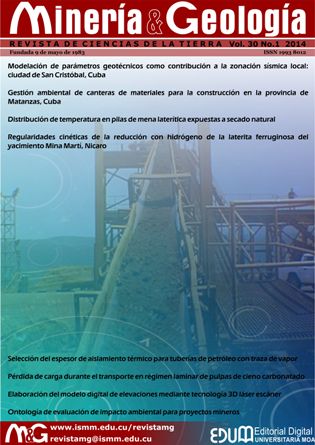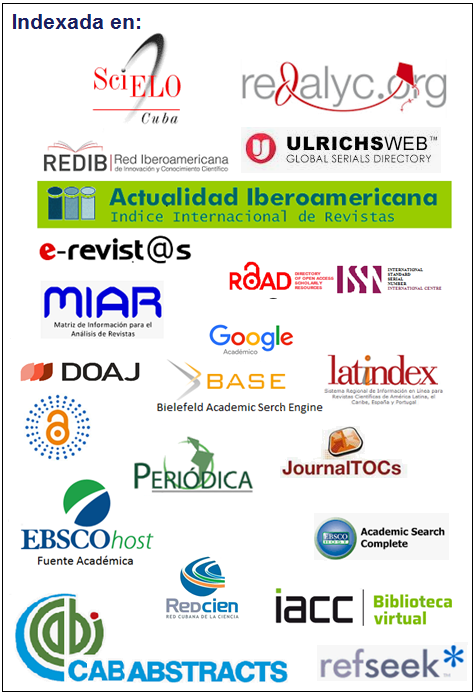Geotechnical parameter modelling as a contribution to the local seismic zonation: San Cristóbal city, Cuba
Keywords:
geotechnical parameters, local seismic zonation, modeling.Abstract
The geotechnical parameters of soils (number of strokes of the standard penetration trial, natural density, content of fine material, liquid limit, humidity and plasticity index are included in the empirical equations to determine the variations of the seismic intensity, transversal waves, susceptibility to liquefaction, among others. Generally, average values are used to characterize the geological formation or geological engineering complex; which causes a great deal of uncertainty. This article proposes a procedure for estimating and modelling the main geotechnical parameters that have an impact on the local seismic zonation. The procedure is divided into 4 stages: the preparation of a data base, an exploratory analysis of data, the development of a 3D geological model and finally the production of a quantitative model. The application of this methodology in the city of San Cristóbal revealed low values of natural density which suggests unfavorable conditions of soils in relation to soil response to seismic activities.Downloads
References
AKIN, M. K.; KRAMER, S. L. & TOPAL, T. 2011: Empirical correlations of shear wave velocity (Vs) and penetration resistance (SPT-N) for different soils in an earthquake-prone area (Erbaa-Turkey). Engineering Geology 119: 1–17.
ANDRUS, R. D. & STOKOE, K. H. 2000: A Liquefaction resistence of soils from shear wave velocity. Journal of Geotechnical and Geoenvironmental Engineering 126(11): 1 015-1 025.
BRANDES, H. G. 2003: Geotechnical and Foundation Aspects. University of Haway, Honolulu [Handbook], 1-61.
BORCHERDT, R. D.; WENTWORTH, C. M.; JANSSEN, A.; FUMAL, T. & GIBBS, J. 1991: Methodology for predictive GIS mapping of spatial study zones for strong ground shaking in the San francisco Bay Region, CA. En: 4th International Conference on Seismic Zonation, p. 5-552.
CHUY, T. J. 1988: Influencia de las condiciones geológicas en la intensidad sísmica de Santiago de Cuba. Movimientos Tectónicos Recientes de Cuba 2: 46-63.
CHUY, T. J. 1999: Macrosísmica de Cuba y su aplicación en los estimados de peligrosidad y microzonación sísmica. Tesis doctoral. Centro Nacional de Investigaciones Sismológicas. Santiago de Cuba. 178 p.
CHUY, T. J. 2003: Macrosísmica de Cuba: su aplicación en los estimados de peligrosidad sísmica. Minería y Geología (1-2): 43-50.
COTILLA, M. 1999: Apuntes necesarios acerca de los acontecimientos sismológicos en Cuba. Anales de Geografía de la Universidad Complutense 19: 71-93.
DIKMEN, U. 2009: Statistical correlations of shear wave velocity and penetration resistance for soils. Journal of Geophysics and Engineering 6: 61–72.
GONZÁLEZ, B. E. & KOGAN, L. A. 1987: Estimación del grado base para el suelo patrón de la ciudad de Santiago de Cuba. Resultados de las Investigaciones de los Proyectos Geofísicos Internacionales. Investigaciones Sismológicas 10: 1-18.
GONZÁLEZ, B. E.; MIRZOEV, K.; CHUY, T. J.; GOLUBIATNIKOV, V. L.; LYSKOV, L. M. & ZAPATA, J. A. 1989: Microzonación sísmica de la ciudad de Santiago de Cuba. Comunicaciones científicas sobre Geofísica y Astronomía. La Habana, 1-14.
GONZÁLEZ, B. E. 1991: Estimación del efecto sísmico en la ciudad de Santiago de Cuba. Tesis doctoral. Instituto de Geofísica y Astronomía. La Habana. 170 p.
GONZÁLEZ, B. E. & PÉREZ, L. D. 2000: Escenarios de peligro sísmico y de fenómenos geotécnicos asociados en municipios urbanos de la ciudad de La Habana. En: 2do Taller de Mitigación y Prevención de Desastres-UNAICC, La Habana, 1-14.
GONZÁLEZ DE VALLEJO, L. I. 2002: Ingeniería Geológica. Pearson Educación. 744 p.
HANUMANTHARAO, C. & RAMANA, G. V. 2008: Dynamic soil properties for microzonation of Delhi, India. Journal of Earth Systen Science 117: 719–730.
HASANÇEBI, N. & ULUSAY, R. 2007: Empirical correlations between shear wave velocity and penetration resistance for ground shaking assessments. Bulletin of Engineering Geology and the Environment 66: 203–213.
HENRÍQUEZ, C. 2007: Mejora de terrenos potencialmente licuables con inyecciones de compactación. Tesis doctoral. Universidad Politécnica de Madrid. 600 p.
HOULDING, S. W. 1994: 3D Geoscience Modelling. Springer-Verlag Berlin Heidelberg, Hong Kong, 309 p.
MEDVEDEV, S. V. 1962: Engineerin seismology. Israel Program for Scientific Translation. Jerusalem. 1-31.
ORDAZ, A.; CHUY, T. J.; HERNÁNDEZ-SANTANA, J. R. & GARCÍA, J. A. 2011: División geológico‐geotécnica aplicada a la zonación sísmica urbana: San Cristóbal, Cuba Occidental. Cuaternario y Geomorfología 26(1-2): 89-104.
PETROVSKI. J. T. 1980: Microzonación sísmica y problemas conexos. En: Terremotos. Evaluación y mitigación de su peligrosidad. Ed. UNESCO, Blume, 50-68.
SEED, H. B. & IDRISS, I. M. 1971: Simplified procedure for evaluating soil liquefaction potential. Jl. Soil Mech. F. Div. ASCE 97 SM 7.
SEED, R. B.; CETIN, K. O.; MOSS, R. E.; KAMMERER, A. M.; WU, J.; PESTANA, J. M.; RIEMER, M. F.; SANCIO, R. B.; BRAY, J. D. & FARIS, A. 2003: Recent advances in soil liquefaction engineering: a unified and consistent framework. En: 26th Annual ASCE Los Angeles Geotechnical Spring Seminar, Keynote Presentation, H.M.S. Queen Mary, Long Beach, California: 1-72.
SIDES, E. J. 1997: Geological modelling of mineral deposit for prediction in mining. Geol Rundsch 86: 342-353.
TECHNICAL COMMITTEE FOR EARTHQUAKE GEOTECHNICAL ENGINEERING, TC4. 1999: Manual for zonation on seismic geotechnical hazards. The Japanese Geotechnical Society, 219 p.
TUTTLE, M.; LAW, K. T.; SEEBER, L. & JACOB, K. 1990: Liquefaction and Ground Failure Induced by the 1988 Saguenay, Quebec, Earthquake. Cannadian Geotechnical Journal 27: 580-589.
WANG, W. 1979: Some Findings in Soil Liquefaction, Research Report, Water Conservancy and Hydroelectric Power Scientiific Research Institute, Beijing, 1-20.
YOUD, T. L. & IDRISS, I. M. 2001: Liquefaction Resistance of Soils: Summary Report from the 1996 NCEER and 1998 NCEER/NSF Workshops on Evaluation of Liquefaction Resistance of Soils. Journal of Geotechnical and Geoenvironmental Engineering 127: 297–313.
YOUD, T. L. & PERKIN, M. D. 1978: Mapping of liquefaction induced ground failure potential. Journal of Geology Engineering 104(4): 433-446.
ZAPATA, J. A. 1996: Utilización de variantes metodológicas de microzonación sísmica en la ciudad de Santiago de Cuba. Tesis doctoral. CENAIS, Santiago de Cuba. 111 p.
Published
How to Cite
Issue
Section
- Authors retain copyright and guaranteeing the right magazine to be the first publication of the work as licensed under a Creative Commons Attribution-NonCommercial that allows others to share the work with an acknowledgment of the work's authorship and initial publication in this journal.
- Authors may establish separate supplemental agreements for the exclusive distribution version of the work published in the journal (eg, place it in an institutional repository or publish it in a book), with an acknowledgment of its initial publication in this journal.
- Authors are allowed and recommended to disseminate their work through the Internet (e.g., in institutional telematic archives or on their websites) before and during the submission process, which can produce interesting exchanges and increase citations of the published work. (See The effect of open access)




